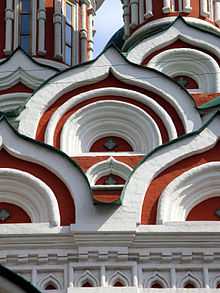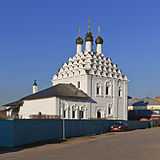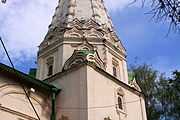Kokoshnik (architecture)

Kokoshnik is a semicircular or keel-like exterior decorative element in the traditional Russian architecture, a type of corbel zakomara (that is an arch-like semicircular top of the church wall). Unlike zakomara that continues the curvature of the vault behind and carries a part of the vault's weight, kokoshnik is pure decoration and doesn't carry any weight. Kokoshnik shares its name with the traditional Russian head-dress worn by women and girls.[1]
Kokoshniks were used in the Russian church architecture from the 16th century, and they were especially popular in the 17th century. They were placed on walls, at the basement of tented roofs or tholobates, over the window frames, or in rows above the vaults.
Examples
-
_27.jpg)
Spassky cathedral of the Andronikov Monastery shows the combination of kokoshniks above and zakomaras below.
-
.jpg)
The Smaller Cathedral of Donskoy Monastery with the three rows of large kokoshniks.
-

The Church of St. Nicholas in Kolomna. Five rows of kokoshniks completely cover the vaults outside.
External references
| Wikimedia Commons has media related to Kokoshniki (architecture). |
Kokoshnik (architecture) in the Great Soviet Encyclopedia (Russian)
References
- ↑ "Of Russian origin: Kokoshnik". Russia Today. Retrieved December 4, 2014.
